| SEARCH |
Invasive Species
Garlic Mustard
Garlic mustard is poised to dominate the plant life of the United States
excerpted from the National Park Service article, Invasion of the Plant Snatchers – Garlic Mustard
- The Garlic Mustard Problem- Worse than Buckthorn
- Garlic Mustard Is Poised To Dominate the Plant Life of the United States
- History of Garlic Mustard
- Garlic Mustard Growth Stages, Identification and Control Methods
- Garlic Mustard Look A-Likes
- Notes Regarding Herbicide Use
- Additional Links
The Garlic Mustard Problem- Worse than Buckthorn
Prohibited Noxious Weedis the designation assigned to garlic mustard by the Minnesota Department of Agriculture. In short, Minnesota law indicates ‘efforts must be made . . . to prevent the reproduction of garlic mustard/prohibited noxious weeds’ on our property. The statute, section 18.78, may be found at here.
Based on my professional opinion and personal field work, garlic mustard is nightmarish to control compared to buckthorn. Using varying methods, I can work on buckthorn control throughout the calendar year. Mature garlic mustard plants on the other hand require immediate attention in orderto avoid dispersal of tens of thousands of seeds that may remain viable in the soil for 12 or more years. If only one garlic mustard plant is left behind to disperse seed, a re-infestation is certain.
Garlic Mustard Is Poised To Dominate
the Plant Life of the United States
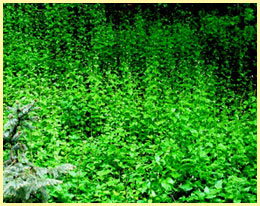 Garlic mustard is poised to dominate the plant life of the United States’. This statement was excerpted from the National Park Service article titled, ‘Invasion of the Plant Snatchers – Garlic Mustard’. The full article may be viewed on the National Park Service website at: http://www.nps.gov/efmo/naturescience/invasion-of-the-plant-snatchers-garlic-mustard.htm
Garlic mustard is poised to dominate the plant life of the United States’. This statement was excerpted from the National Park Service article titled, ‘Invasion of the Plant Snatchers – Garlic Mustard’. The full article may be viewed on the National Park Service website at: http://www.nps.gov/efmo/naturescience/invasion-of-the-plant-snatchers-garlic-mustard.htm
How could garlic mustard dominate plant life in the United States? As a non-native biennial plant, garlic mustard is without natural predators in our region. Research indicates it is possible for a single garlic mustard plant to develop and disperse up to 8000 seeds in just one season. Each of those 8000 seeds can remain viable in the soil and germinate over a term of up to 12 or more years.
It only takes one garlic mustard seed, unknowingly carried off in the tread of a boot, ATV wheel tread, deer hoof, and dog’s paw, pant cuff, stuck to a shoelace, etc., and dropped in another location to start a massive new infestation. Without control measures, garlic mustard will blanket a woodland understory in a few years. choking out native plants and tree seedlings in the process.
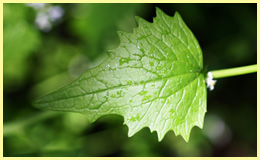 Garlic mustard can alter the chemical composition of surrounding soil and inhibit the successful germination and growth of many native plants. This characteristic allows garlic mustard to establish itself as a monoculture (single species). The resulting loss of native plants eliminates the food, shelter and reproductive/nesting areas necessary to sustain wildlife. Wildlife populations decline as they leave in search of new habitat or face death. Species extinction becomes the ultimate threat.
Garlic mustard can alter the chemical composition of surrounding soil and inhibit the successful germination and growth of many native plants. This characteristic allows garlic mustard to establish itself as a monoculture (single species). The resulting loss of native plants eliminates the food, shelter and reproductive/nesting areas necessary to sustain wildlife. Wildlife populations decline as they leave in search of new habitat or face death. Species extinction becomes the ultimate threat.
History of Garlic Mustard
Garlic mustard intentionally accompanied European immigrants to the U.S. in the mid-1800s. Garlic mustard was favored for its food value, medicinal benefits and as a form of erosion control. No surprise on the latter! The immigrants were unaware of the future devastation that would result.
Garlic mustard is a biennial plant in the mustard family. In its native European habitat, garlic mustard has nearly three dozen natural enemies that keep its growth and spread under control. Unfortunately, garlic mustard has NO natural enemies in the U.S. to control its growth and spread. Biological controls are being considered but none have been officially approved for release as of the writing of this article.
Garlic Mustard Growth Stages, Identification and Control Methods
 1. Garlic mustard seedlings germinate from seeds dispersed by mature plants inprevious growth seasons. Two-leafed seedling semerge in spring, typically March in Minnesota. A significant percentage of garlic mustard seedlings will out-compete each other. Control options at this growth stage could include a foliar treatment using the herbicide glyphosate at a dose of 1% to 2%. Foliar herbicide treatments in early spring or late fall minimize damage to many native plants which may still be dormant at those times. Always read and follow the herbicide manufacturers label directions and safety precautions. Another control option shown to have a limited effect at eliminating garlic mustard seedlings is the use of an LP torch designed for weed control. Check with local authorities to determine if a burn permit is required. Exercise extreme caution with this control method. There is always a risk of wild fire and/or personal injury. In my opinion, this is not a desirable control method in most cases.
1. Garlic mustard seedlings germinate from seeds dispersed by mature plants inprevious growth seasons. Two-leafed seedling semerge in spring, typically March in Minnesota. A significant percentage of garlic mustard seedlings will out-compete each other. Control options at this growth stage could include a foliar treatment using the herbicide glyphosate at a dose of 1% to 2%. Foliar herbicide treatments in early spring or late fall minimize damage to many native plants which may still be dormant at those times. Always read and follow the herbicide manufacturers label directions and safety precautions. Another control option shown to have a limited effect at eliminating garlic mustard seedlings is the use of an LP torch designed for weed control. Check with local authorities to determine if a burn permit is required. Exercise extreme caution with this control method. There is always a risk of wild fire and/or personal injury. In my opinion, this is not a desirable control method in most cases.
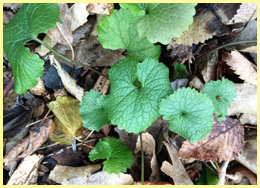 2. Spring seedlings mature into rosettes throughout year one. At this stage, garlic mustard is easily confused with several native plants and other non-native plants. Refer to the comparison photos in Segment 5 of this article for accurate identification of garlic mustard.
2. Spring seedlings mature into rosettes throughout year one. At this stage, garlic mustard is easily confused with several native plants and other non-native plants. Refer to the comparison photos in Segment 5 of this article for accurate identification of garlic mustard.
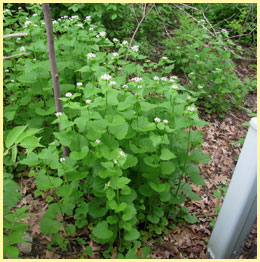
3. In late April to early June in Minnesota, during garlic mustard’s second year of growth, the heart-shaped leaves of the rosette morph into a triangular shape.Flower stalks bolt upward and produce clusters of 4-petaled, 1/4″ diameter white flowers.The early flowering growth stage is the most ideal time to hand-pull garlic mustard plants. Remove the entire tap root to prevent re-sprouting of garlic mustard plants.Tamp disturbed soil back into place. Gently shake soil loose from roots and place small bundles of pulled plants in a location with NO soil contact and roots exposed toward the sun. Suitable locations include tree and shrub branch crotches, across dead logs, on top of wood piles or rock piles, etc. These garlic mustard plants should dry out, decompose and return nutrients to the soil. If plants are allowed to have soil contact they will often re-root and continue growing to seed dispersal stage.Safe levels of foliar herbicide use have shown only minimal impact on garlic mustard during its flowering stage. Mowing or weed whipping at this growth stage, prior to the appearance of developed siliques, can buy time until garlic mustard plants can be pulled. Mowing and weed whipping keep garlic mustard growth at bay but flowers will eventually reappear.
 4. Soon after blossoming, seed pods (“siliques”) which look like miniature green beans began to develop from the blossoms.Siliques typically appear in June-July in Minnesota but timing varies greatly subject to location. After silique development is evident, hand-pull as in Segment 3 above but DO NOT LEAVE GARLIC MUSTARD SEED HEADS IN THE WOODLAND TO DECOMPOSE. Even though garlic mustard has been uprooted, the energy stored in the plant at this growth stage is sufficient for siliques to develop viable seeds.
4. Soon after blossoming, seed pods (“siliques”) which look like miniature green beans began to develop from the blossoms.Siliques typically appear in June-July in Minnesota but timing varies greatly subject to location. After silique development is evident, hand-pull as in Segment 3 above but DO NOT LEAVE GARLIC MUSTARD SEED HEADS IN THE WOODLAND TO DECOMPOSE. Even though garlic mustard has been uprooted, the energy stored in the plant at this growth stage is sufficient for siliques to develop viable seeds.
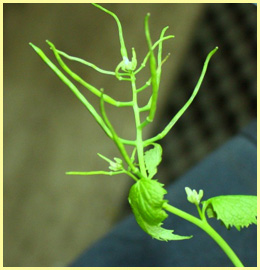 After silique development, it is critical that garlic mustard seed heads be properly disposed of to avoid causing future contamination and infestation. If possible, burn dried plants in a fire pit or other safe, suitable location. Be aware of and follow any fire code restrictions in your area. If burning is not feasible, bag and tie plants or secure plants within two tarps that can be left indefinitely to decompose. NEVER PLACE GARLIC MUSTARD SILIQUES IN PRIVATE OR MUNICIPAL COMPOSTING SITES.
After silique development, it is critical that garlic mustard seed heads be properly disposed of to avoid causing future contamination and infestation. If possible, burn dried plants in a fire pit or other safe, suitable location. Be aware of and follow any fire code restrictions in your area. If burning is not feasible, bag and tie plants or secure plants within two tarps that can be left indefinitely to decompose. NEVER PLACE GARLIC MUSTARD SILIQUES IN PRIVATE OR MUNICIPAL COMPOSTING SITES.
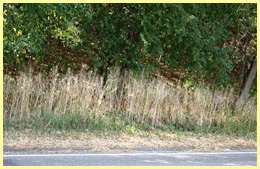 5. By August the garlic mustard siliques become dry and straw colored as they burst open and distribute seed in a radius of up to 10″. These dispersed seeds will germinate in future spring seasons and repeat the biennial cycle.
5. By August the garlic mustard siliques become dry and straw colored as they burst open and distribute seed in a radius of up to 10″. These dispersed seeds will germinate in future spring seasons and repeat the biennial cycle.
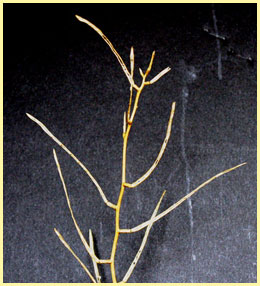 Removing a single season’s garlic mustard crop does not eliminate garlic mustard from an area. Germination and survival of only a few seeds will lead to a re-infestation in future years. Continued maintenance is critical in controlling garlic mustard.
Removing a single season’s garlic mustard crop does not eliminate garlic mustard from an area. Germination and survival of only a few seeds will lead to a re-infestation in future years. Continued maintenance is critical in controlling garlic mustard.
Garlic Mustard Look A-Likes
During the rosette growth stage, garlic mustard may easily be confused with similar looking plants. Refer to these photos for assistance in correct identification of garlic mustard:
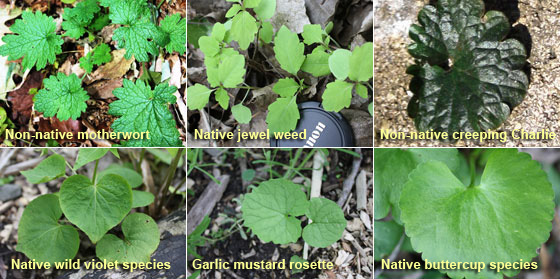
Note on Garlic Mustard Herbicide Treatment
Notes Regarding Herbicide Use: Before applying any herbicide, always read and follow the manufacturer’s label directions and safety precautions.
Minnesota state law requires that any applicator hired to apply herbicide to a customer’s property be commercially licensed and carry their license on their person. This is for environmental protection and the protection of property and individuals. Please report violators to the MN Department of Agriculture at 651-201-6333.
Additional Links
MN noxious weeds list http://www.mda.state.mn.us/plants/pestmanagement/weedcontrol/fsmnwp.aspx
USDA Forest Service garlic mustard data http://www.fs.fed.us/database/feis/plants/forb/allpet/all.html
MN DNR campaign to stop invasive species spread http://playcleango.org/involved.html
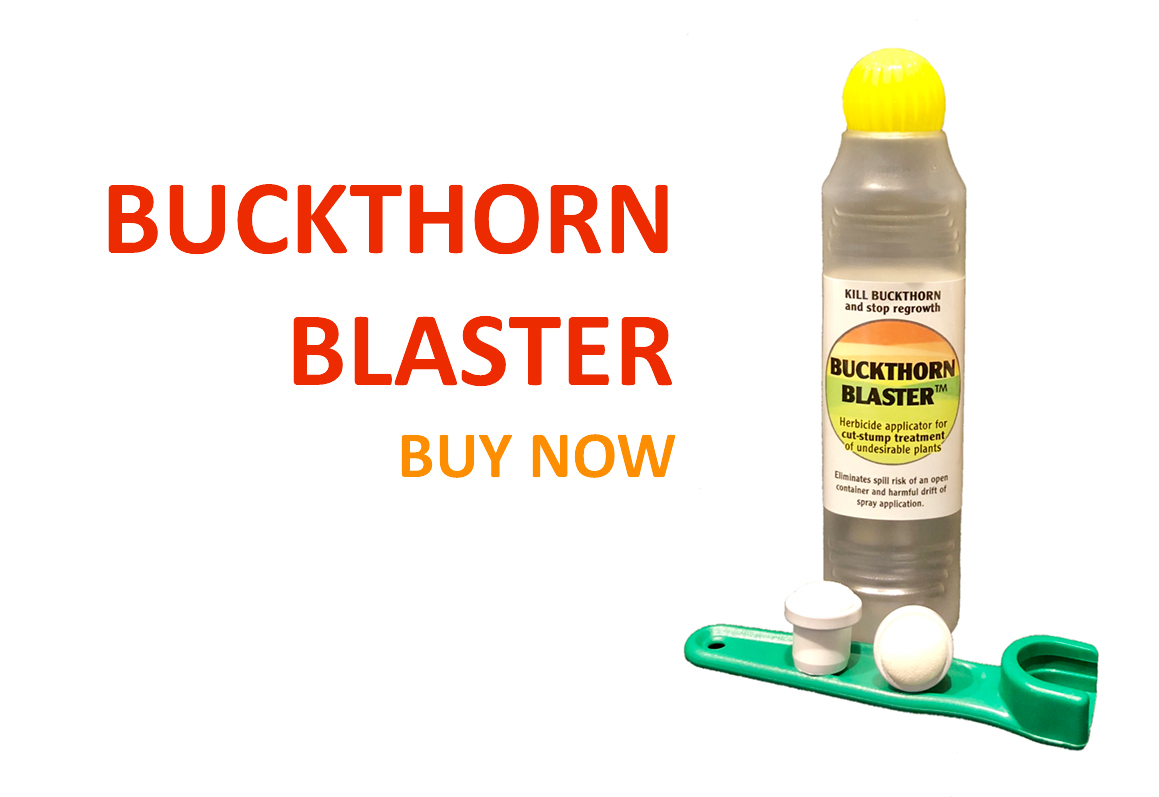
Buckthorn Buy Now
Landscape Restoration, Inc. is the exclusive distributor of the Buckthorn Blaster™ herbicide applicator.
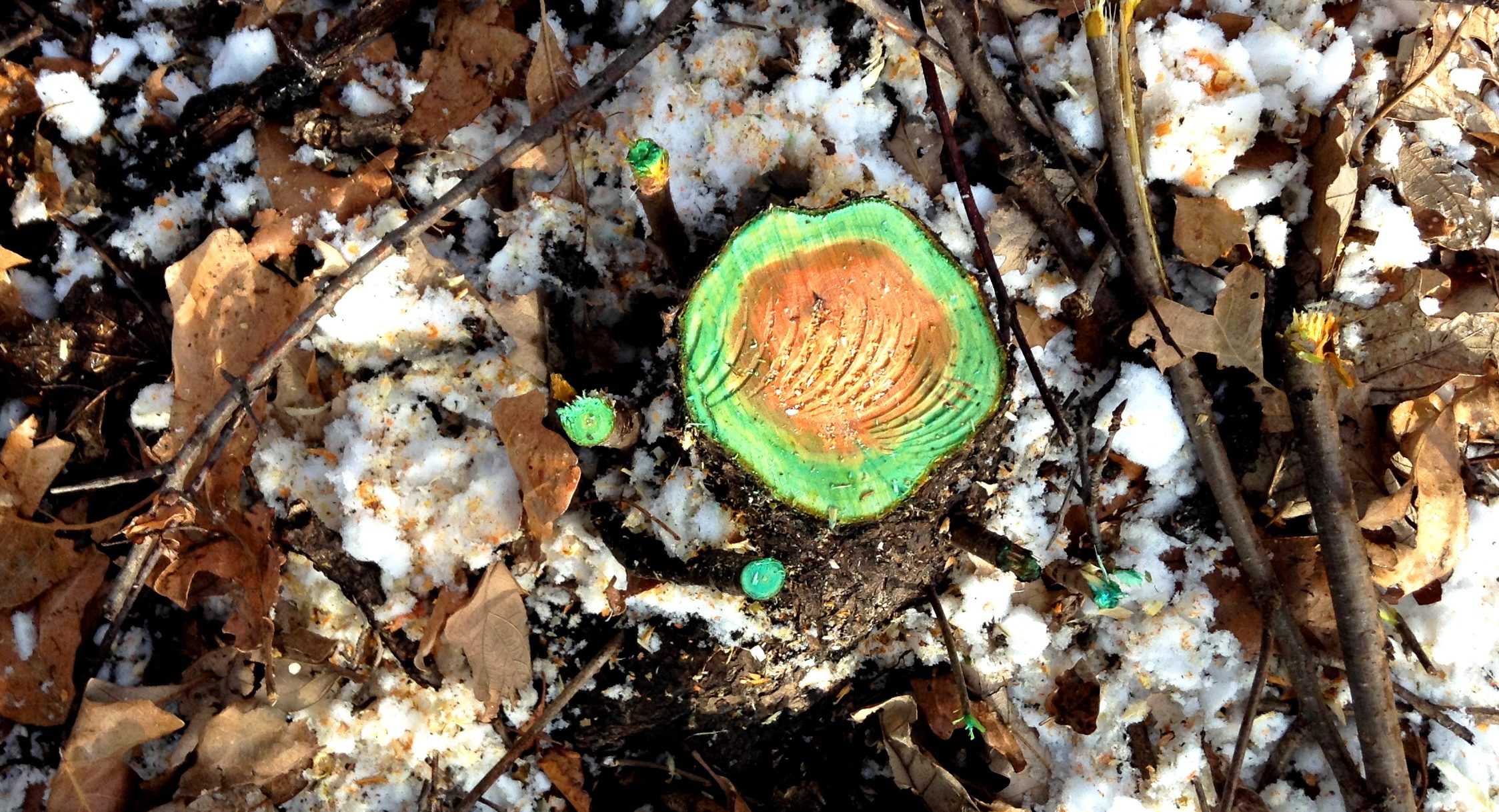
Services
We can come to your property to remove and control invasive species such as buckthorn and garlic mustard.
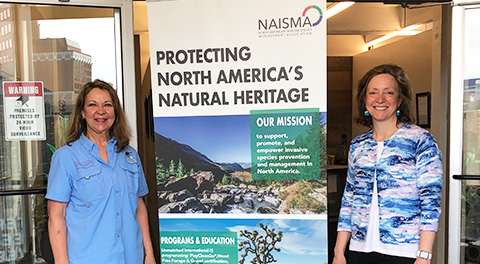
Workshops
Landscape Restoration, Inc. provides educational seminars and workshops for individuals and organizations.


